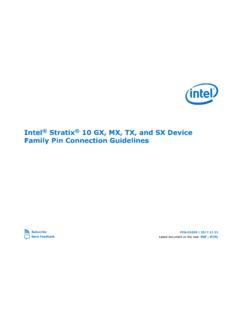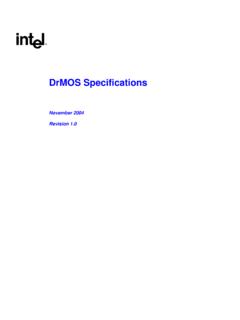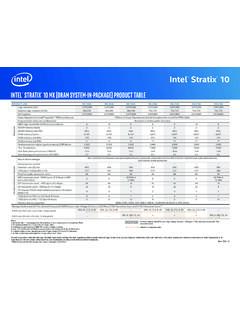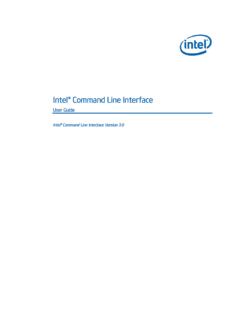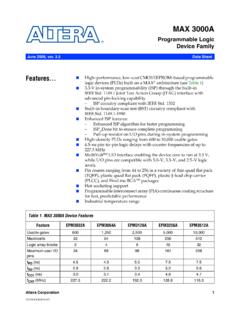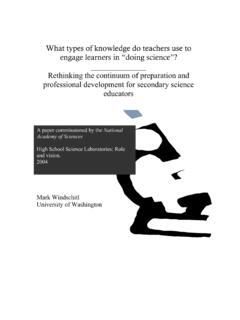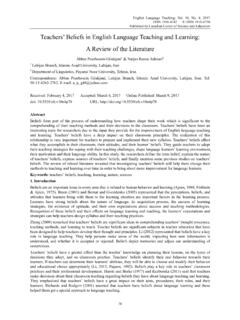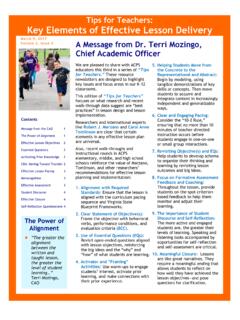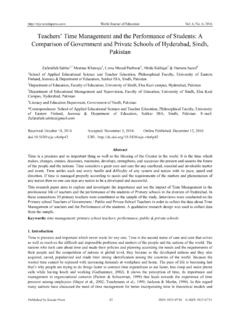Transcription of Benefits of ProjectBased Learning - Intel
1 Intel Teach Program Designing Effective Projects Overview and Benefits of Project-Based Learning Introduction Introducing projects into the curriculum is not a new or revolutionary idea in education. During the past decade, however, the practice has evolved into a more formally defined teaching strategy. Project-based Learning has gained a greater foothold in the classroom as researchers have documented what teachers have long understood: Students become more engaged in Learning when they have a chance to dig into complex, challenging, and sometimes even messy problems that closely resemble real life. Project-based Learning goes beyond generating student interest.
2 Well-designed projects encourage active inquiry and higher-level thinking (Thomas, 1998). Brain research underscores the value of these Learning activities. Students' abilities to acquire new understanding are enhanced when they are "connected to meaningful problem-solving activities, and when students are helped to understand why, when, and how those facts and skills are relevant" (Bransford, Brown, & Conking, 2000, p. 23). What is project-based Learning ? Project-based Learning is an instructional model that involves students in investigations of compelling problems that culminate in authentic products. Projects that make for stronger classroom Learning opportunities can vary widely in subject matter and scope, and can be delivered at a wide range of grade levels.
3 Nonetheless, they tend to share defining features. Projects grow out of challenging questions that cannot be answered by rote Learning . Projects put students in an active role such as: problem solver, decision maker, investigator, or documentarian. Projects serve specific, significant educational goals; they are not diversions or adds-ons to the "real" curriculum. How does project-based Learning relate to inquiry? Inquiry encompasses a broad range of activities that give reign to our natural curiosity about the world. Within the context of education, inquiry takes on a more specific meaning. Teachers who use inquiry as a strategy typically encourage students to raise questions, plan and carry out investigations, make observations, and reflect on what they have discovered.
4 However, this is not a static definition. Even within a single classroom, inquiry activities may be taking place along a continuum, from more structured and teacher -directed on one end to more open-ended and driven by student interest on the other (Jarrett, 1997). It may be helpful to think of project-based Learning as a subset of inquiry Learning . A review of research about project-based Learning concludes that such projects are focused on questions or problems that "drive students to encounter (and struggle with) the central concepts and principles of a discipline" (Thomas, 2000, p. 3). What's more, the central activities of a project involve inquiry and the construction of new knowledge by the student (Thomas, 2000).
5 Students typically have a choice when it comes to designing their project, which allows them to pursue their interests and engage their curiosity. In the course of answering their own questions, students may investigate topics not identified by the teacher as Learning goals. What are the Benefits of the project-based Learning model? Project-based Learning offers a wide range of Benefits to both students and teachers. A growing body of academic research supports the use of project-based Learning in school to engage students, cut absenteeism, boost cooperative Learning skills, and improve academic performance (George Lucas Educational Foundation, 2001). For students, Benefits of project-based Learning include: Increased attendance, growth in self-reliance, and improved attitudes toward Learning (Thomas, 2000).
6 Academic gains equal to or better than those generated by other models, with students involved in projects taking greater responsibility for their own Learning than during more traditional classroom activities (Boaler, 1997; SRI, 2000 ). Copyright 2012 Intel Corporation. All rights reserved. Page 1 of 4. Intel Teach Program Designing Effective Projects Opportunities to develop complex skills, such as higher-order thinking, problem-solving, collaborating, and communicating (SRI, 2000). Access to a broader range of Learning opportunities in the classroom, providing a strategy for engaging culturally diverse learners (Railsback, 2002). For many students, the appeal of this approach to Learning comes from the authenticity of the experience.
7 Students take on the role and behavior of those working in a particular discipline. Whether they are making a documentary video about an environmental concern, designing a travel brochure to highlight sites of historical significance in their community, or developing a multimedia presentation about the pros and cons of building a shopping mall, students are engaged in real-world activities that have significance beyond the classroom. For teachers, additional Benefits include enhanced professionalism and collaboration among colleagues, and opportunities to build relationships with students (Thomas, 2000). Additionally, many teachers are pleased to find a model that accommodates diverse learners by introducing a wider range of Learning opportunities into the classroom.
8 Teachers find that students who benefit the most from project-based Learning tend to be those for whom traditional instructional methods and approaches are not effective (SRI, 2000). How does this model transform a more traditional classroom? A professional development presentation developed by Intel Teach to the Future (2003) describes a classroom where the teacher is using the project-based Learning model effectively. In such a setting: There is a problem with no predetermined answer There is an atmosphere that tolerates error and change Students make decisions with a framework Students design the process for reaching a solution Students have a chance to reflect on the activities Assessment takes place continuously A final product results and is evaluated for quality For students accustomed to a more traditional school experience, this means a transformation from following orders to carrying out self-directed Learning activities; from memorizing and repeating to discovering, integrating, and presenting.
9 From listening and reacting to communicating and taking responsibility; from knowledge of facts, terms, and content to understanding processes; from theory to application of theory; from being teacher dependent to being empowered ( Intel , 2003). What are the challenges facing teachers? Teachers who bring project-based Learning into the classroom may have to adopt new instructional strategies to achieve success. Having the teacher take the role of guide or facilitator is not the way that most educators were taught, nor even the way they were taught to teach. Direct-instruction methods that rely on textbooks, lectures, and traditional assessments do not work well in the more open-ended, interdisciplinary world of project-based Learning .
10 Rather, teachers do more coaching and modeling and less "telling." They need to be comfortable with "wrong turns" that students may make en route to completing a project ( Intel , 2003). Teachers may find themselves Learning alongside their students as projects unfold. Specific challenges facing teachers include: Recognizing situations that make for good projects Structuring problems as Learning opportunities Collaborating with colleagues to develop interdisciplinary projects Managing the Learning process Integrating technologies where appropriate Developing authentic assessments Copyright 2012 Intel Corporation. All rights reserved. Page 2 of 4. Intel Teach Program Designing Effective Projects Indeed, teachers may have to be willing to take risks to overcome initial challenges.
